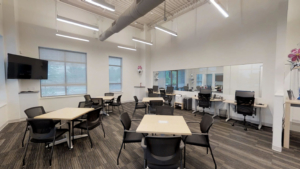The COVID-19 pandemic has put extraordinary pressures on life as we (used to) know it. Companies are suddenly thrust into conducting business in new, creative ways in order to survive. Best case, they have been doing many of these things already, or had at least prepared to do them. Worst case, they hadn’t even thought about them.
 With “non-essential” businesses and their employees locked safely at home, everyone has had to grow more and more comfortable with conducting business from home. This means mastering the teleconference (Zoom, GoToMeeting, Skype, Facetime, and many others). They are working in the cloud, or VPN-ing into the office. (Hopefully, the IT infrastructure was in place before the stay-at-home order was invoked, or quickly put in place shortly thereafter.) They have to juggle work obligations, managing kids at home from school, being productive amoungst a myriad of distractions, and dealing with the stress that comes with it all!
With “non-essential” businesses and their employees locked safely at home, everyone has had to grow more and more comfortable with conducting business from home. This means mastering the teleconference (Zoom, GoToMeeting, Skype, Facetime, and many others). They are working in the cloud, or VPN-ing into the office. (Hopefully, the IT infrastructure was in place before the stay-at-home order was invoked, or quickly put in place shortly thereafter.) They have to juggle work obligations, managing kids at home from school, being productive amoungst a myriad of distractions, and dealing with the stress that comes with it all!
Hopefully, the pandemic will subside quickly and we can all get back to the “new normal.” In the meantime, Gontram Architecture has been pondering what the “new normal” may mean for design and architecture…
Social Distancing:
 Social distancing is a term everyone is all too familiar with these days. It is not a stretch to speculate that the practice is here to stay. While the face masks, gloves, and hand sanitizer may decrease in use, keeping a proper distance from one another may be a wise practice. Hand shaking may go by the wayside (which is fine with me).
Social distancing is a term everyone is all too familiar with these days. It is not a stretch to speculate that the practice is here to stay. While the face masks, gloves, and hand sanitizer may decrease in use, keeping a proper distance from one another may be a wise practice. Hand shaking may go by the wayside (which is fine with me).
Many Pediatrician’s offices have long had a “healthy” waiting room and a “sick” waiting room. We will not be surprised if that strategy is employed in ALL offices of healthcare providers. At a minimum, waiting room sizes will grow and capacities will shrink to allow more space between patients in general.
At restaurants, there will be a larger push to develop better takeout and delivery options – something they have had to get used to very quickly. There may be a larger effort to space tables further apart from each other.
 Physical barriers may be incorporated more into retail checkouts and other customer-employee interaction areas, which is contrary to what most businesses are trying do in order to build the business relationship. Doing so in a thoughtful manner will be important – not just hang a sheet of clear acrylic from the ceiling in front of the cashier!
Physical barriers may be incorporated more into retail checkouts and other customer-employee interaction areas, which is contrary to what most businesses are trying do in order to build the business relationship. Doing so in a thoughtful manner will be important – not just hang a sheet of clear acrylic from the ceiling in front of the cashier!
While congregating (sports, movies, concerts, church, etc.) will return to normal as quickly as safely possible, businesses can begin to adapt models and strategies that can make their employees, customers, patients, etc. feel safe given this recent experience.
Work from Home:
Even before the COVID-19 crisis, Fortune 500 companies were already beginning to experiment with more flexible schedules and work-from-home policies. Microsoft, for example, experimented with enhanced work-life arrangements in their Japanese offices during the summer of 2019 (click here for article) with broadly positive feedback. The majority of participants (92%) reported increased happiness and were able to accomplish the same amount of work in fewer weekly hours. Ultimately, Microsoft reported a net productivity gain of +40% per-hour-worked during the study. Overhead costs such as printing (-58% reduction) and electricity (-23% reduction) also declined. From a forward-looking architectural perspective, with fewer employees in the office on any given day, office space requirements should decline proportionately. Open office designs, which allow for employees to use any available workstation, suit this enhanced work-life arrangement particularly well.
 Efforts in creating more flexible schedules with increased work-from-home capabilities are coming at an important inflection point in United States demographics. As one generational bubble (boomers) begins to increasingly rely on care from others, the next generational bubble (millennials) are entering peak household formation and reproductive years. With both eldercare and childcare ramping up at the same time, the burden of responsibility placed on prime-age-workers will increase with it. Employers that adapt to these changing needs without sacrificing productivity should expect improved employee happiness and retention in this new economy.
Efforts in creating more flexible schedules with increased work-from-home capabilities are coming at an important inflection point in United States demographics. As one generational bubble (boomers) begins to increasingly rely on care from others, the next generational bubble (millennials) are entering peak household formation and reproductive years. With both eldercare and childcare ramping up at the same time, the burden of responsibility placed on prime-age-workers will increase with it. Employers that adapt to these changing needs without sacrificing productivity should expect improved employee happiness and retention in this new economy.
With more employees working from home, there may be a reduced demand for office space. Or, more likely, there will be an increased need for flexible office space. After months of working from home, much of the population will be ready to get back to an office environment. While some may still work from home part of the time, full-time work-at-home personnel may be rare. Humans are social creatures and desire social contact. You can’t satisfy that need very easily in your home office. While large conference rooms may become a thing of the past, smaller more flexible meeting rooms may be even more important in future office design.
Touchless means Touch Less
 One of the easiest ways to encourage a clean and sanitary working environment is to make as many devices as possible touchless. And, one of the easiest places to do it is in the restroom. Touchless faucets, soap dispensers, paper towel dispensers, urinals and toilets are already mainstream, but should be mandatory. Simple design decisions (like making doors swing out from restrooms so the door can be pushed open with an arm instead of having to grab a handle with your clean hand) can make the biggest difference. When space allows, eliminate the doors altogether and use sight traps instead.
One of the easiest ways to encourage a clean and sanitary working environment is to make as many devices as possible touchless. And, one of the easiest places to do it is in the restroom. Touchless faucets, soap dispensers, paper towel dispensers, urinals and toilets are already mainstream, but should be mandatory. Simple design decisions (like making doors swing out from restrooms so the door can be pushed open with an arm instead of having to grab a handle with your clean hand) can make the biggest difference. When space allows, eliminate the doors altogether and use sight traps instead.
Doors will become automatic opening, wherever practical and economically justifiable. Where not practical, additional hardware can be installed to eliminate the need to grab the door handle with a clean hand.

 In retail, we will see more ordering with mobile apps or web browsers. In-store pickup areas will be more prevalent. There will be even more self-checkouts than there are today. There may even be more grab-and-go arrangements like what Amazon is beginning to employ: Customers simply fill their bags with stuff and leave the store. Technology takes care of scanning your purchases and billing your account without cash or credit cards changing hands.
In retail, we will see more ordering with mobile apps or web browsers. In-store pickup areas will be more prevalent. There will be even more self-checkouts than there are today. There may even be more grab-and-go arrangements like what Amazon is beginning to employ: Customers simply fill their bags with stuff and leave the store. Technology takes care of scanning your purchases and billing your account without cash or credit cards changing hands.
Self-serve food bars may dwindle or become more restrictive, but that demand will shift to other restaurant or food delivery services.
In the End…
Some good always comes out of devastating events.
Performing routine business has been transformed forever. Online meetings have not only proved to be extremely productive, but the necessity of having them has required everyone to get comfortable with them and begin to accept them as invaluable. The large conference room may have become a dinosaur. Electronic document production will become even more commonplace. And, design for sanitary and effective environments will become essential.
After COVID-19, businesses will (hopefully) be better prepared for the next devastating event. If not, they will perish the quick death they most likely experienced during this one.
